How to Grow Cucumbers the Right Way
Author: Jen Worst | Editor: Omar Alonso
Review & Research: Jen Worst & Chris Miller
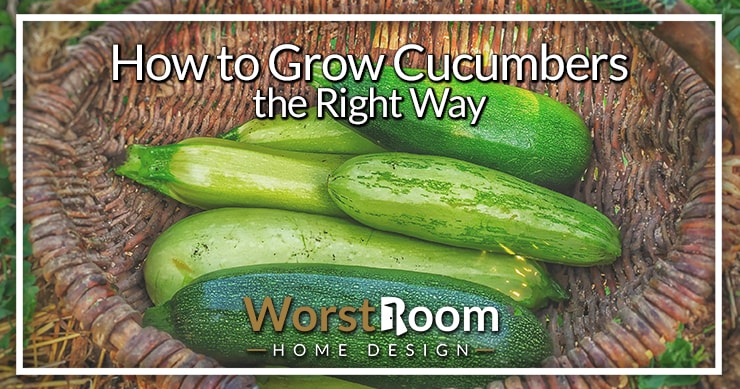
Cucumbers are famously known as a green vegetable, but they are actually a fruit (yes, you read that right). Knowing how to grow cucumbers opens up an entire culinary avenue in your kitchen and brings the joy of gardening into your life.
Cucumbers are a healthy food; they're almost free of any calories by being full of water, anti-oxidants, and soluble fiber. They're the ultimate calorie-conscious snack food.
The water content in them is extra high, so it helps in staying hydrated during the summer. We all know how essential it is for our body to remain hydrated, and eating foods rich in water makes it easier to fulfill your hydration needs.
Cucumbers are rich in vitamins like vitamin C and K, and they're also rich in minerals like manganese, magnesium, and potassium. As we said, cucumbers are rich in anti-oxidants. They're a top-tier health food, for sure.
Cucumber is a refreshing addition to your table, especially during the summer season. People use it in their salads, sandwiches, burgers, eat it with hummus, use it in shawarma, wraps, etc.
Cucumbers are a great addition to your vegetable garden, they are easy to grow and won’t require a lot of your attention.
How to Grow Cucumbers
Here is a complete guide for growing cucumbers. You want them in your life. Let's make that happen.
Where to Plant Cucumbers
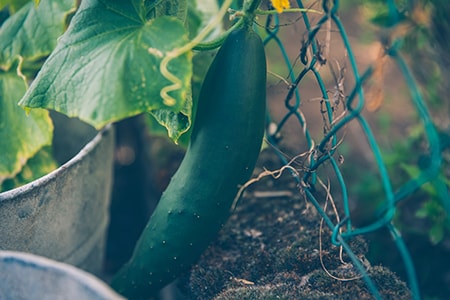
Unlike many vegetable plants, cucumber plants are very flexible when it comes to requirements. Even if you plant your cucumber plants in soil that contains clay, your cucumber plants will grow just fine.
In such a case, you need to make sure that your cucumber plants are well-watered. It's also essential that you want to prevent root rot, so you need to make sure the soil drains well.
However, in ideal conditions, a cucumber plant requires loose soil. In addition to that, you need to improve your soil with compost so that your cucumber plants can get the nutrition they require.
It's an excellent practice to add compost to the soil once again a month after the first tendrils have appeared. Learn about the type of soil you've planted in and add in the nutrients that are missing by balancing the fertilizer numbers.
Since these are climbing vegetables, you can even let them grow on cages or trellises like you would with tomato plants, if you so desire. This works well if you have less space for a sizable garden.
You may ask "how do cucumbers grow?" and the answer is pretty much however you want them to. Whatever you give the tendrils to grab onto is where they will grow.
When to Plant Cucumbers
Cucumbers thrive the best when planted between late spring and late fall. They're a warm-season crop that require a lot of moisture since they're largely comprised of water. They don't tolerate frost well due to this reason as well.
In a mild climate you'll want to plant them between April and June (in the United States). If you're in a warmer region, consider planting them as early as late February or early March. The goal is to plant them early enough that the soil and air is at least 65 degrees Fahrenheit.
How to Plant Cucumbers
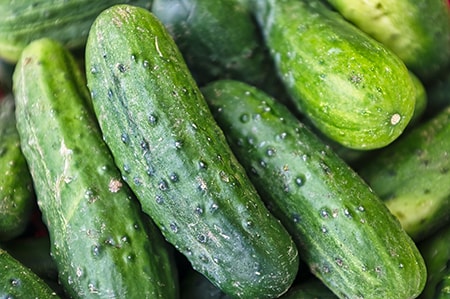
Planting cucumber plants is very simple and straightforward. No matter what you are starting with (plants or seeds), make sure you plant them in the soil when its temperature is at least 65 degrees Fahrenheit.
You can plant your cucumbers initially inside your house. After 3 to 4 weeks, when the plants have grown enough, you can plant them outside so that they can start consuming natural sunlight. Since cucumber plants grow relatively quickly, the period of 3 to 4 weeks can vary a little.
Whether you are growing cucumbers from seeds or seedlings, make sure you plant them only a few inches deep. This is essential to follow because cucumber plants have a shallow root system.
This means that their roots grow close to the surface of the ground. Therefore, if you bury the roots too deep, there will be a chance of root rot. They don't like to be submerged in water for long.
Remember, cucumber plants need a lot of space to grow well. A few of these plants can grow and occupy your garden almost wholly. When growing along a trellis, cucumber plants need an area of at least 18 inches between them.
If you are going to grow your cucumbers directly in your garden, leave three feet between two cucumber plants. Having so much space to grow, cucumber plants can easily sprawl, which is needed for them to fully thrive.
What Do Cucumber Plants Look Like?
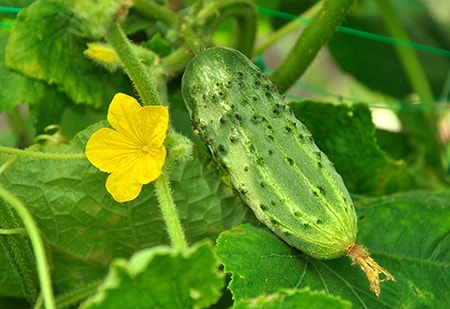
Cucumber plants are a vine crop who's vines can reach as long as 8 feet or more. In a large cucumbers garden, given enough space one plant can cover as much as 50 square feet. They don't grow upwards much unless provided a trellis or cage for the vines to grasp on to.
Cucumber leaves begin as oval seed leaves but mature into a triangular and lobed shape with toothy edges. Though the edges are serrated, they aren't firm. The surface of the leaves will become fuzzy with soft hairs. The color will be a lush green.
The vines will be long but intertwine with one another and grow enough leaves that they don't look like vines at all but more like a ground cover bush. The vines also produce yellow flowers. And of course they have the large cucumber fruit attached, either dangling in the air or lying on the ground.
Caring for Cucumbers
Maintenance and care are essential if you want your cucumber plants to be happy and healthy. Thankfully, they don't need any extraordinary care.
Cucumber plants love sunlight, which is their most primary requirement. Make sure your plants get at least 5 to 7 hours of proper and direct sunlight per day. If you can provide them up to 8 or 9 hours of daylight, they'll grow their best.
If you don't water your them enough, they will produce fruits with a bitter flavor. So build watering into your routine or you'll regret not having done so.
When it comes to watering, you need to give your cucumber plants about 1 to 2 inches of water every week. If the temperatures are high, you can increase this amount accordingly.
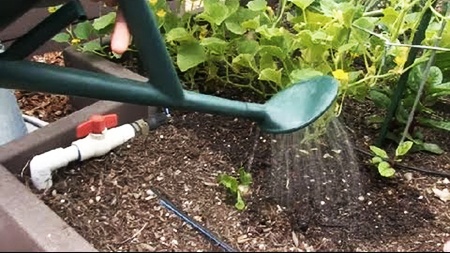
It's a good idea to add a layer of straw mulch on warm soil about four weeks after planting. It helps keep beetles and slugs away and keep the fruit clean. You may need to consider preventing spider mites (learn more with our article Where Do Spider Mites Come From?)
Moreover, pruning cucumbers plants helps in maintaining the balance between fruit production and vine growth. For this part, you can remove damaged or dead portions to get well-trimmed cucumber vines.
Also, as needed during the growing season, you can prune outside leaves, flowers, branches, and even fruits. Theplant will be full of lush green leaves. For those who don't know, nitrogen-rich soil is essential for leafy plants.
These plants need nitrogen for improved leaf growth before the fruit appears. Therefore, we recommend you to feed your plants with an organic fertilizer of 10-7-7 balance. Or, you can use a fertilizer with a 7-5-5 or 6-3-3 balance as well. You can learn more about these fertilizer numbers here.
How Long Do Cucumbers Take to Grow?
Unlike other vegetables, harvesting cucumbers is very simple. It's the easiest part of growing cucumbers! When it's time to harvest, take as many cucumbers as you can because picking promotes further growth.
Cucumbers are large, so they naturally require a long growing season. After germination, most types of cucumbers are ready to harvest in 50 to 70 days. If you want a crispier texture, collect them in the morning.
If you want to eat your cucumbers fresh, harvest them when they are firm, 7 to 9 inches in length, and 1 to 1.5 inches in diameter. Additionally, pick them when they are ripe, having a bright medium to dark green color.
While picking your cucumbers, make sure to leave a small part of the stem attached to the cucumbers. If your cucumbers get more massive than the size mentioned above, they will likely taste bitter and have a more inferior texture.
Storing Cucumbers
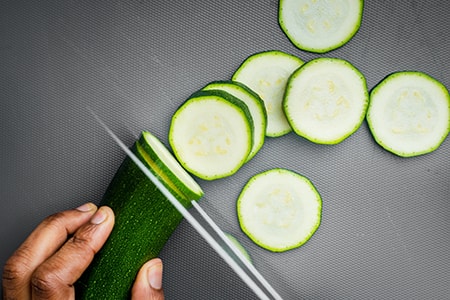
If you follow every step of our how to grow cucumbers guide correctly, you will get a healthy plant that gives you 10 to 15 cucumbers in 3 weeks. And if you have two plants, you will get at least 20, which is may be a little too much for one household to use while fresh.
Thus, you should know how to store and preserve your extra cucumbers so that they aren't wasted. We believe that refrigeration is the best way to store cucumbers. According to experts, you can store your cucumbers in your fridge and preserve them for a week if you do it the right way.
This is how to keep sliced cucumbers fresh. First of all, wash your harvested cucumbers and clean them properly so that they are free of dirt. Then, dry them so that the excess water doesn't start the spoilage process.
After that, wrap your cucumbers in a towel (or a paper towel or paper towel alternatives placed on dish), and place them in a plastic bag. The towels will reduce condensation and prevent deterioration, whereas the plastic bag is for protection from external threats like ethylene gas. Then, place the package in the crisper drawer of your fridge.
Diseases Found In Cucumber Plants
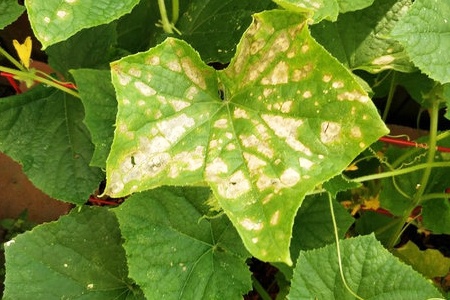
While growing cucumbers, don't forget about the cucumber beetle. These beetles are the biggest pest-related threat to your cucumbers, and you should be afraid of them. Try to be ever-watchful, and don't let this pest attack your plant.
The cucumber beetle harms your plant by eating it, but that's not the worst part. The actual problem starts when the beetle spreads diseases like bacterial wilt and mosaic virus in your cucumber plants.
To find out if cucumber beetles have reached your garden, use adhesive traps. If you find one of the beetles on your trap, go to your garden and dig out around the stems of your plants. If you find any larvae there, immediately destroy them.
You can save your plants from these beetles by simply using floating row covers. That being said, don’t forget to remove the covers when the flowers appear so that important pollinators can play their part.
That's How to Grow Cucumbers!
Growing cucumbers is not difficult as they are hardy plants and can tolerate a lot more than other plants. They are excellent healthy food, and if you can grow them in your backyard or vegetable garden, then why not?
They are a fantastic diet snack, and if you are growing them in your garden, you can make sure that they are organic. Once you get to taste home-grown cucumbers, you will never go back to the store brought ones. Learn how to grow cucumbers and you'll continue doing it for life.



